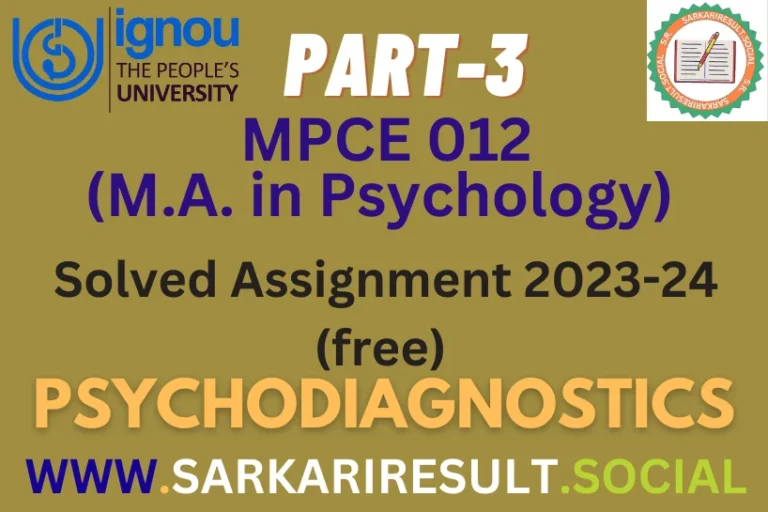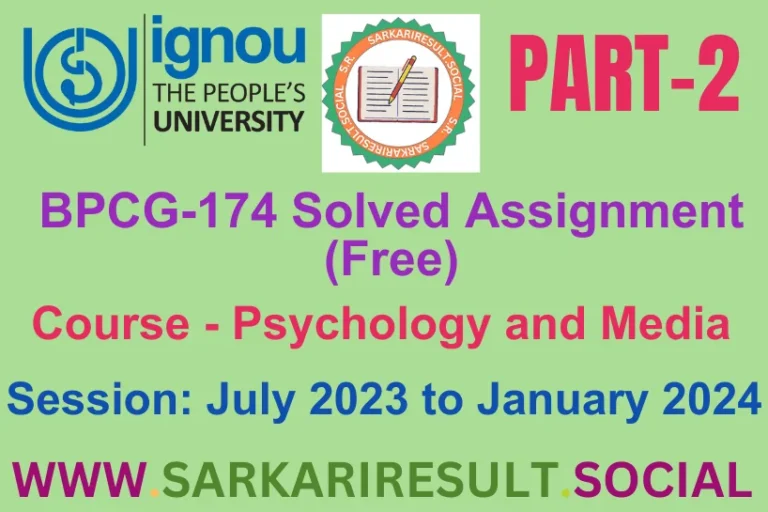BEGG 172 SOLVED IGNOU ASSIGNMENT FREE PART 3

Embark on a comprehensive exploration of Language and Linguistics BEGG 172 SOLVED IGNOU ASSIGNMENT FREE PART 3 in Section C with our detailed IGNOU Solved Assignments 2024. Engage with questions based on Blocks 1 to 4, providing in-depth answers within approximately 700 words each. Identify the nature of language variation, categorize factors leading to it. Delve into the concepts of stress and rhythm in connected speech with relevant examples. Distinguish between various kinds of inflectional affixes using suitable examples. Lastly, discuss the creation of coordination relations in compound sentences and explore the semantic implications of such coordination links.

Answer each question in about 700 words. (Based on Blocks 1 to 4)
Q.1 Identify the nature of language variation and categorize various factors that lead to language variation.
Ans. Nature of Language Variation:
Language variation refers to the diversity and differences in how language is used among speakers and communities. It’s a natural and inherent aspect of any language, reflecting the dynamic nature of human communication. There are various dimensions of language variation, including regional, social, and situational factors, each contributing to the multifaceted nature of language.
1. Regional Variation:
– Dialects: Regions often develop distinct dialects, characterized by differences in pronunciation, vocabulary, and even grammatical structures. For example, British English and American English have notable differences in spelling, vocabulary, and some aspects of pronunciation.
– Accents: Within regions, accents can vary significantly. Even small geographical areas may exhibit unique ways of pronouncing words.
2. Social Variation:
– Socioeconomic Status: Language can vary based on socioeconomic factors. People from different socioeconomic backgrounds may use language in distinct ways, influencing vocabulary choices and speech patterns.
– Educational Background: Education levels can impact language variation. More formal or technical language may be used by those with higher education, while informal language might prevail in less formal settings.
3. Situational Variation:
– Formality: Language can vary based on the formality of a situation. Formal language might be used in professional settings or academic writing, while informal language is typical in casual conversations.
– Code-Switching: Speakers may switch between different languages or varieties within a single conversation, known as code-switching. This often happens in multilingual communities.
Factors Contributing to Language Variation:
1. Historical Factors:
– Language Contact: When different linguistic communities interact, language contact can lead to variations. Loanwords, borrowings, and influences from one language to another contribute to linguistic diversity.
– Language Evolution: Over time, languages evolve, leading to changes in vocabulary, grammar, and pronunciation. Historical events and cultural shifts also influence language development.
2. Social Factors:
– Social Identity: Language is a crucial aspect of identity. People may modify their language use to align with or differentiate themselves from particular social groups. This can be based on ethnicity, gender, or other social markers.
– Peer Influence: Social groups and peer networks can shape linguistic norms. Individuals may adopt certain language features to fit into or distinguish themselves within their peer groups.
3. Geographic Factors:
– Isolation: Geographic isolation can lead to linguistic divergence. Communities separated by geographical barriers may develop distinct linguistic features over time.
– Migration: Movement of people across regions brings linguistic influences. Migrants may introduce new words, expressions, and pronunciation to the areas they move to.
4. Cultural Factors:
– Traditions and Customs: Cultural practices and traditions influence language. Certain words or expressions may be specific to particular cultural contexts.
– Media and Technology: The influence of media, including television, movies, and the internet, contributes to language variation. New technologies may introduce new vocabulary and ways of expression.
5. Individual Factors:
– Age: Language use varies across age groups. Younger generations may adopt new slang and expressions, while older individuals might adhere to more traditional language norms.
– Personal Style: Individual speakers may have distinct language styles and preferences. Some individuals may be more prone to language innovation, while others might be conservative in their language use.
Conclusion:
Language variation is a rich and dynamic aspect of linguistic diversity. It reflects the complexity of human interaction, social structures, and cultural influences. Rather than seeing language variation as a deviation from a norm, it should be embraced as a fundamental and natural feature of any living language. Understanding the factors contributing to language variation enhances our appreciation for the versatility and adaptability of language across different contexts and communities.
Q.2 Discuss the concepts of stress and rhythm in a connected speech by giving suitable examples.
Ans. When we listen to people speaking, we often notice patterns in the way words are emphasized or pronounced. These patterns are related to the concepts of stress and rhythm in connected speech, making language sound natural and dynamic.
1. Stress in Connected Speech:
Stress in language refers to the emphasis placed on certain syllables within words or on certain words within a sentence. Stressed syllables are pronounced more prominently, with increased loudness, higher pitch, and sometimes longer duration compared to unstressed syllables. This prominence can change the meaning or tone of a word or sentence.
Example 1:
– Re’port (noun): The stress is on the first syllable, indicating a document or news.
– re’port (verb): The stress is on the second syllable, meaning to convey information.
Example 2:
– in’sult (noun): The stress is on the first syllable, indicating an offensive remark.
– in’sult (verb): The stress is on the second syllable, meaning to offend someone.
2. Rhythm in Connected Speech:
Rhythm in language is the pattern of stressed and unstressed syllables in a sequence. English is considered a stress-timed language, which means that the stressed syllables are more evenly spaced, creating a rhythmic pattern. Unstressed syllables may be squeezed together or stretched out to maintain this rhythm.
Example 1:
– I’ love’ eat’ing ice’ cream’ in the sum’mer. The stressed syllables are more evenly spaced, creating a rhythmic flow.
Example 2:
– To’mor’row, I’m’ go’ing to’ the’ beach. Again, the stressed syllables are evenly spaced, creating a rhythm.
How Stress and Rhythm Work Together:
In connected speech, stress and rhythm work hand in hand to create natural, fluid communication. Here’s how:
1. Word Stress:
In many English words, only one syllable is stressed. This is often the case with nouns, verbs, adjectives, and adverbs. Changing the stressed syllable can change the meaning.
– con’tract (noun): A formal agreement.
– con’tract (verb): To make or enter into a contract.
2. Sentence Stress:
Within a sentence, certain words are more stressed than others, contributing to the overall rhythm. Content words (nouns, verbs, adjectives, adverbs) are usually stressed more than function words (prepositions, articles, pronouns).
– I can’t BELIEVE she did that. (Stressed words: can’t, BELIEVE)
3. Intonation:
Intonation involves the rise and fall of pitch in speech. Changing the intonation can convey different emotions or indicate question versus statement.
– You’re GOING to the store. (Statement)
– You’re going to the STORE? (Question)
4. Reduced Forms:
In connected speech, unstressed syllables often become weaker and may even be reduced or dropped. This is common with function words.
– I’m going to the store. (Fully pronounced)
– I’m gonna go to the store. (Reduced form: gonna)
5. Pausing and Grouping:
Native speakers naturally group words together in phrases, pausing slightly between these groups. This grouping aids in clarity and adds to the rhythm.
– She said (pause) she would call (pause) later.
Practical Implications:
Understanding stress and rhythm in connected speech is crucial for effective communication. It helps convey meaning, highlight important information, and adds a natural flow to speech. For language learners, becoming attuned to these patterns improves comprehension and aids in sounding more native-like.
In essence, stress and rhythm in connected speech are the musical elements of language, contributing to its expressive and dynamic nature. Just like in music, where certain notes are accented or certain beats are stressed, language uses stress and rhythm to convey meaning, emotion, and emphasis.
Q.3 Distinguish between different kinds of Inflectional Affixes by giving suitable examples.
Ans. Inflectional affixes are morphemes that are added to words to convey grammatical information, such as tense, number, case, gender, or mood. They don’t change the core meaning of the word but provide additional details about its grammatical context. Here, we’ll distinguish between different kinds of inflectional affixes with suitable examples.
1. Tense Markers:
– Definition: Tense markers indicate the time of action, whether it’s in the past, present, or future.
– Examples:
– walked (past tense)
– walks (present tense)
– will walk (future tense)
2. Number Markers:
– Definition: Number markers indicate whether a noun is singular or plural.
– Examples:
– cat (singular)
– cats (plural)
– child (singular)
– children (plural)
3. Gender Markers:
– Definition: Gender markers indicate the gender of nouns in languages that have gender distinctions.
– Examples:
– amigo (male friend in Spanish)
– amiga (female friend in Spanish)
4. Case Markers:
– Definition: Case markers indicate the grammatical role of a noun within a sentence (subject, object, etc.).
– Examples:
– He saw the cat. (nominative case)
– I gave the book to him. (dative case)
5. Mood Markers:
– Definition: Mood markers indicate the speaker’s attitude towards the action, whether it’s a statement, command, wish, etc.
– Examples:
– She walks to the store. (indicative mood)
– Walk to the store. (imperative mood)
– If I were you, I would walk. (subjunctive mood)
6. Voice Markers:
– Definition: Voice markers indicate the relationship between the action and the participants (active or passive voice).
– Examples:
– The cat chased the mouse. (active voice)
– The mouse was chased by the cat. (passive voice)
7. Degree Markers:
– Definition: Degree markers indicate the intensity of an adjective or adverb.
– Examples:
– big (positive degree)
– bigger (comparative degree)
– biggest (superlative degree)
8. Person Markers:
– Definition: Person markers indicate the grammatical person of the subject in verb conjugations.
– Examples:
– I walk (first person)
– You walk (second person)
– He/She/It walks (third person)
9. Aspect Markers:
– Definition: Aspect markers indicate the nature of the action, whether it’s ongoing, completed, or repeated.
– Examples:
– She is walking to the store. (progressive aspect)
– She has walked to the store. (perfect aspect)
10. Number-Gender Agreement:
– Definition: Some languages require agreement between nouns and adjectives or articles in terms of both number and gender.
– Examples:
– el libro rojo (the red book, masculine singular in Spanish)
– los libros rojos (the red books, masculine plural in Spanish)
– la mesa roja (the red table, feminine singular in Spanish)
– las mesas rojas (the red tables, feminine plural in Spanish)
Understanding the distinctions between these inflectional affixes is essential for grasping the grammatical nuances of a language. It allows speakers to communicate precisely and provides a systematic structure for constructing sentences in various contexts. These affixes contribute to the flexibility and expressiveness of languages, making them rich and intricate systems for communication.
Q.4 Discuss how relations of coordination are created in compound sentences and the various semantic implications of such coordination links.
Ans. In language, coordination refers to the combining of words, phrases, or clauses of equal syntactic rank. Compound sentences, formed through coordination, consist of two or more independent clauses linked together by coordinating conjunctions or punctuation. Understanding these relations and their semantic implications is vital for constructing clear and nuanced sentences.
1. Coordinating Conjunctions:
– Definition: Coordinating conjunctions connect words, phrases, or clauses of equal importance.
– Examples:
– He is studying hard, and he will succeed.
– She likes coffee, but she prefers tea.
– Semantic Implications: Coordinating conjunctions such as “and,” “but,” “or,” and others imply a relationship of addition, contrast, choice, or consequence. They contribute to the logical flow of ideas, allowing the speaker or writer to express connections between thoughts.
2. Punctuation:
– Definition: A compound sentence can also be formed by using a semicolon (;) or a comma with a coordinating conjunction.
– Examples:
– She enjoys reading; he prefers watching movies.
– The weather is nice, so we decided to go for a walk.
– Semantic Implications: Punctuation in compound sentences indicates a pause or a more significant break between clauses. It adds a sense of rhythm and can convey a subtle shift in focus or tone.
3. Correlative Conjunctions:
– Definition: Correlative conjunctions work in pairs to connect elements of equal importance.
– Examples:
– Either you come to the party, or I’ll go alone.
– Both the cat and the dog are adorable.
– Semantic Implications: Correlative conjunctions emphasize a sense of choice, mutual exclusivity, or parallelism. They contribute to clarity and precision in expressing relationships between elements.
4. Conjunctive Adverbs:
– Definition: Conjunctive adverbs (e.g., however, therefore, moreover) can connect independent clauses in a compound sentence.
– Examples:
– She worked hard; however, she didn’t achieve her goal.
– We planned a picnic; moreover, the weather was perfect.
– Semantic Implications: Conjunctive adverbs often indicate contrast, consequence, or additional information. They contribute to the overall coherence of the sentence.
Semantic Implications of Coordination Links:
1. Addition:
– Example: She likes both chocolate and vanilla ice cream.
– Semantic Implication: The coordination link “and” suggests an additive relationship. This is a common way to express cumulative information or preferences.
2. Contrast:
– Example: He is passionate about his job, but he struggles to find work-life balance.
– Semantic Implication: The coordination link “but” indicates a contrasting relationship. It introduces a shift in focus or a conflict between the two clauses.
3. Choice:
– Example: You can either join us for dinner, or you can stay home.
– Semantic Implication: The correlative conjunction “either…or” suggests a choice. It implies that the listener can select one of the presented options.
4. Cause and Effect:
– Example: The traffic was heavy, so we arrived late.
– Semantic Implication: The coordinating conjunction “so” indicates a cause-and-effect relationship. It connects the consequence (arriving late) to the preceding situation (heavy traffic).
5. Condition:
– Example: If it rains, we will stay indoors.
– Semantic Implication: The subordinating conjunction “if” introduces a condition. It establishes a relationship where the action in the second clause is dependent on a specific condition being met.
6. Alternatives:
– Example: You can take the train or drive to work.
– Semantic Implication: The coordinating conjunction “or” suggests alternatives. It presents two options without implying any specific relationship between them.
Understanding the various coordination links and their semantic implications empowers speakers and writers to craft sentences that effectively convey relationships between ideas. Whether expressing addition, contrast, choice, or other connections, coordination is a powerful tool for constructing clear and cohesive compound sentences.
Also See This: BEGG 172 SOLVED IGNOU ASSIGNMENT FREE PART 1







